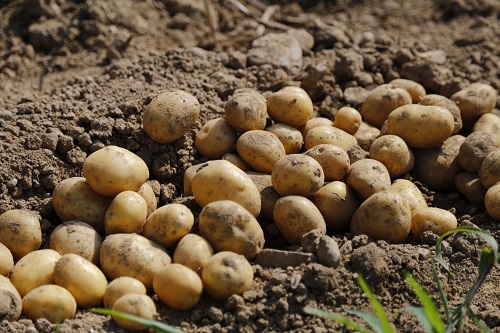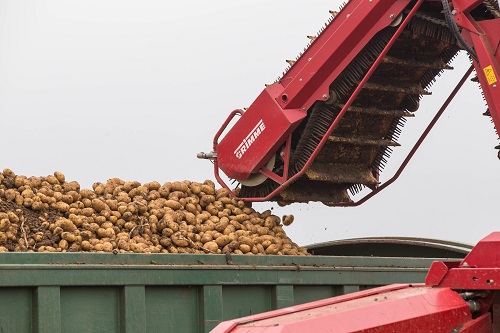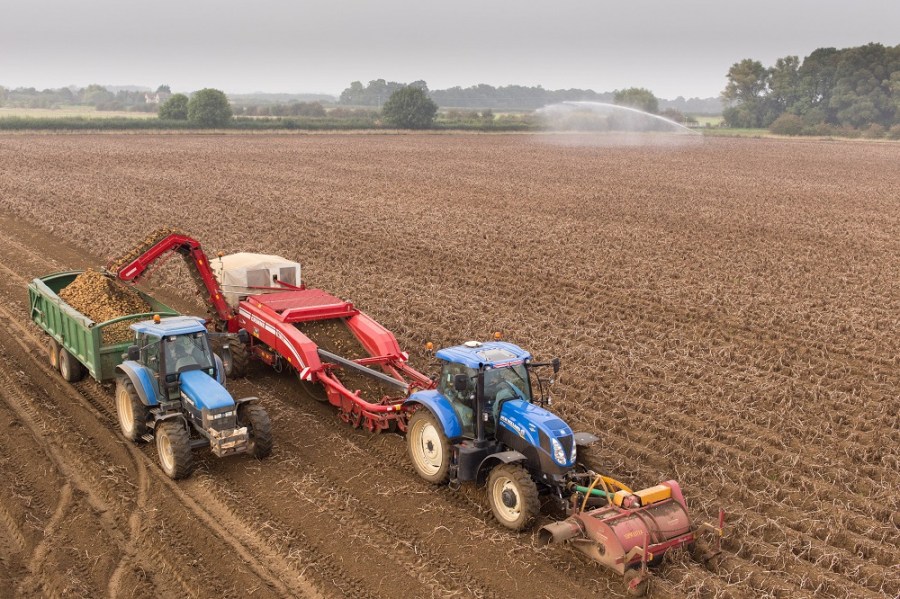An expected shortfall in potato yields across Europe is likely to support potato prices but for growers on fixed-price contracts, this season has a sting in its tail. CPM reports.
Some buyers are trying to hold growers to their full contracts without any movement on price or specification.
By Lucy de la Pasture and Paul Spackman
With potato prices looking healthy, there’s likely to be at least some compensation for growers for the lower yields widely expected after the dry summer. But for growers on a contract, things are looking less rosy.
NFU Horticulture and Potatoes Adviser Lee Abbey, says buyers need to review contracts and prices on the back of one of the most challenging growing seasons in living memory. “The extreme weather events of 2018 have been out of growers’ control and it would take the most stone-hearted buyer not to recognise that.

Potato digs are revealing many crops are down on yield and size this season, with free-buy potatoes in scarce supply to fill contract shortfalls
“Yields are down across the country. There isn’t a single grower out there who hasn’t worked all hours of the day to try and manage the crop as best they can and their efforts should be applauded, not penalised,” he says.
According to AHDB, the UK planted area is down by 3% this season to 119,000ha, the third lowest area on record, which is another contributory factor to the tight supply of potatoes.
The NFU has been in touch with a number of packers, processors and retailers over the past couple of months, he says, asking how they intend to deal with yield and quality issues and calling on them to apply flexibility and fairness when dealing with shortages.
“The vast majority have said they will review specifications (some have already made changes) and will communicate closely with their suppliers to manage the crop as best they can. There’s a clear recognition that everyone has to pull together to get the most out of the diminished crop. And as this is a northern hemisphere issue, it’s not like there are many spare potatoes elsewhere to get hold of.”
And therein lies the problem. Throughout north western Europe the NEPG (North-Western European Potato Growers) reports the potato crop will be much lower yielding and quality issues may also be a challenge due to the extreme drought and exceptional temperatures recorded in all the main potato growing countries within Europe.
With less than 50 % of the NW European potato acreage irrigated, and restrictions on the use of water which have been imposed by some regional administrations, experts in France consider yields will be a minimum of 15-25% lower than the long-term average.
About 70% of the potato crop in the mainland NEPG countries is contracted, mainly with the processing industry, though in the UK the proportion on contracts is slightly lower. Many growers throughout Europe report that they will probably not be able to supply their contracted volume, which poses a real problem if they’re held to their contracts by buyers.
It’s a problem that Lee is keen to help growers overcome. “I‘m still hearing of many NFU members coming up against brick walls when talking to their customers. Remarkably some buyers are trying to hold growers to their full contracts without any movement on price or specification. It’s difficult to understand the logic,” he says.

For growers who have insufficient potatoes to fulfil their contracts, cheap European imports won’t be available this season to ease their situation.
With free-buy potatoes hard to come by and very expensive, it’s a potentially devastating position for any grower to find themselves in if they’re held to their contracted tonnage, he adds.
Lee points out that with most potatoes grown on contract at fixed prices, the extra costs involved in managing this year’s crop, plus the loss of income from lower yields means growers are significantly out of pocket.
“With the number of growers reducing in the UK, and many customers building better, longer term relationships with their suppliers, growers no longer have to stand for one-sided, risky contracts. Buyers playing hard ball may find they have very few suppliers left next year,” he adds.
The concerns around this season’s crop have been reflected in the benchmark April-19 European processing potatoes futures contract, says AHDB analyst Aidan Wright. “This has closed between €279/t to €320/t for the last two weeks and remains significantly higher at this point in time than April contracts in previous years.”
“With approximately 70% of the mainland NEPG potato area under contract, a reduction in yields will drive buyers onto the free-buy market to meet shortfalls in contracted volumes. With limited potatoes expected to be available on the free-buy market this year and increased competition, prices on the continent are likely to stay supported throughout the season.”
Over the past five years (2012-17) the UK has imported 281kt of fresh potatoes from the EU each season, on average, says Aidan. “A reduction in European production is unlikely to reduce imported volumes. In 2012/13, a season of low supply caused by adverse weather, the UK still managed to import 683kt of fresh potatoes.
“However, the likely price increase of these supplies over the season means that cheap European imports are unlikely to act as a cap on domestic prices this season, for some markets. This may exacerbate the problems that are expected to emerge in the domestic market this year,” he warns.
“While the percentage of the GB area dedicated to contract growing remains below that of the continent, a shortfall in expected supplies is likely to lead to a similar situation to that on the continent. Essentially increased competition for free-buy supplies would typically provide support for prices, which is unlikely to be capped by an influx of competitively priced imports,” says Aidan.
Lee is calling for more support for British growers. “A price increase for next year is needed if growers are going to plant the same volume again. But a price increase for this year should also be on the table,” he says.
“It’s difficult to look ahead to 2019 when 2018 is still throwing so many challenges our way. But it’s worth remembering that the NFU offers helpful advice on contracts so that members are better prepared to enter a new agreement.”
Fenland trials give agronomy insights
Every season brings fresh challenges for potato agronomy, but Hutchinsons’ trials in Suffolk are developing ways to overcome them. From tighter pesticide regulations to unpredictable pest and disease threats, the issues facing potato growers are diverse and constantly changing.
Yet potato research is often overshadowed by other crops, which is why Hutchinsons established its Fenland Potato Demonstration at A.L Lee Farming Company’s Friesland Farm near Mildenhall, says root crop technical manager Darryl Shailes.
Now in its second season, the trials provide a fascinating insight into ways of improving yield, quality and profitability, he says. Six areas are under investigation, and although full results will not be available until a post-harvest meeting on 30 Nov, there have already been some interesting observations.
The post-emergence herbicide trial shows some big variations in crop effects, such as scorch and mottling, from eight different treatments on 15 varieties.
“On this fertile soil, many varieties are fairly tolerant until you get to higher doses or certain product combinations, when bigger differences start to show,” explains Daryl.
“But even on this forgiving land, moisture stress had a big effect. We’ve seen more adverse effects from all treatments, with crops taking longer to grow away from damage compared with last year when there was more moisture at the right time. So, a benefit versus risk analysis always needs to be done and it may be different every season.”
Given limited screening of new varieties by herbicide manufacturers, he says the trial provides a valuable insight into possible options for crops under high weed pressure. Dry weather in June and July also highlighted possible physiological benefits from strobilurin and SDHI chemistry used in the seed disease management trial.
A range of seed treatment and in-furrow options is being tested on plots of Markies planted on 3 May. Although all emerged quickly with no discernible visual differences at first, Farmacy agronomist John Chamberlain says there’s an average of 1.5 more stems where SDHI or strobilurin chemistry was used.
“It’s only an observation at this stage, but more stems generally means more tubers, so it will be interesting to see if differences carry through to harvest.”
Analysis of the site with the FungiAlert service, which uses soil sensors and lab analysis to detect and identify a range of microorganisms, revealed a mixture of pathogenic types and a ‘surprising’ number of beneficials, many associated with bio-control agents.
FungiAlert co-founder Dr Angela de Manzanos Guinot says the in-field sensors improve the timeliness of soil health analysis over traditional sampling, allowing more targeted, preventative action.
Another trial examining how chronological age of Scottish Maris Piper seed and different physiological ageing methods affect stem/ tuber number and marketable yield is also showing differences.
Two seed lots were used; the ‘older’ seed had a 50% emergence date of 5 May, around a month before the ‘younger’ seed lot, explains Stefan Williams, Farmacy agronomist at Friesland Farm.
For each type, four ageing treatments were used, including seed straight from store warmed for 24 hours before planting, four-week chit, eight-week chit and eight-week chit with chits removed.
Initial findings show across all four treatments, younger seed produced 27% more stems on average than older seed, producing 4.5 stems/ plant compared with 3.5.
There were also clear differences in speed of emergence between physical ageing treatments, with the ‘cold store’ and ‘chits knocked off’ plots noticeably slower than the four and eight-week chits.
“Potatoes use a lot of energy producing chits, so you must protect them. Knocking chits off induces a shock reaction where seed generates more stems, using energy,” explains Stefan.
“Historically the farm chitted seed for 8-9 weeks but doing so risks more damage to larger chits on the planter, which increases crop variability. Next season we may chit seed for four weeks given what we’ve found.”
The site also hosts two trials examining integrated potato cyst nematode control. The first compares effects of four nematicide treatments on marketable yield in replicated plots of Maris Peer, and the impact on soil PCN multiplication. Products include Mocap (ethoprop), Nemathorin (fosthiazate), Vydate (oxamyl) and a new Bayer treatment promising activity at very low application rates.
A second trial is investigating the performance of 15 varieties with different PCN resistance and tolerance and their impact on PCN multiplication. Each variety is being evaluated under treated and untreated conditions, with soil PCN counts taken before planting and after harvest.
“In the short-term, growing tolerant varieties on PCN-infected land allows decent yields, but longer-term PCN can increase considerably unless varieties have good resistance,” says John Keer of Richard Austin Agriculture.
“The really interesting part of both trials will be the impact on PCN multiplication through the season, which we’ll know when soil counts are taken after harvest.”
A decision to buy a three-row planter on the host farm prompted another trial to determine optimum seed spacing. Three plots of Markies have been sown at 40, 50 and 60cm spacing and will be assessed for yield and grade after harvest.
“A two-row planter at 40cm spacing uses roughly the same amount of seed as a three-row planter at 60cm, but we want to see what effect this has on tuber number and size,” notes Stefan.




